It looks like you're using an Ad Blocker.
Please white-list or disable AboveTopSecret.com in your ad-blocking tool.
Thank you.
Some features of ATS will be disabled while you continue to use an ad-blocker.
10
share:
Here are some photos recently released that show the newly discovered oxidized and decayed orbs found under the temple of the feathered serpent at
Teotihuacan, Mexico.
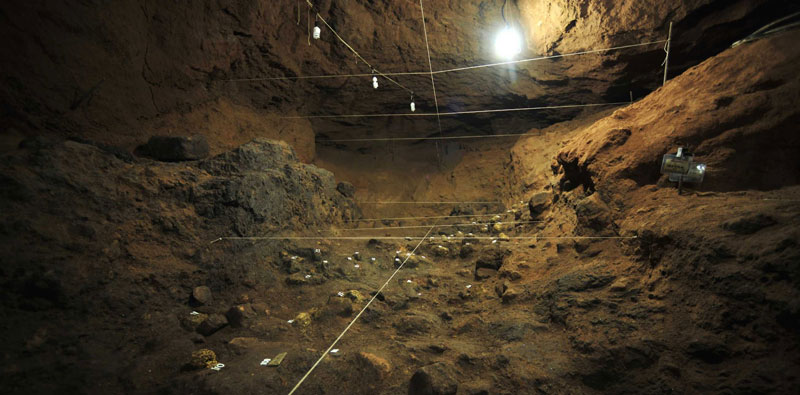
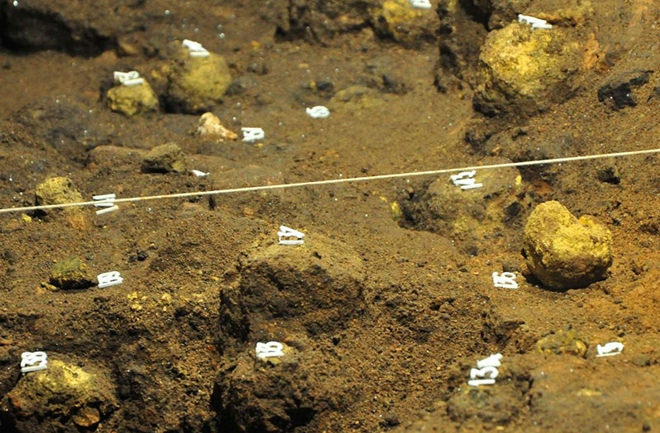
If those yellow spots really were once orbs then they possibly represent the spheres on Xiuhcoatl’s snout. Xiuhcoatl is known as the Aztec fire serpent and it is adorned on the façade of the feathered serpent temple at Teotihuacan. Here are a few pictures of Xiuhcoatl.
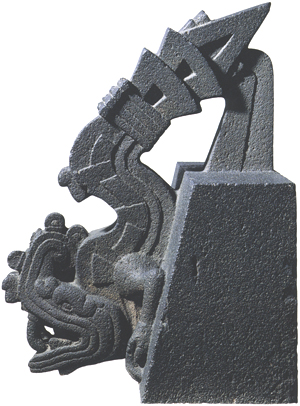
Xiuhcoatl has the tail of a rattlesnake.
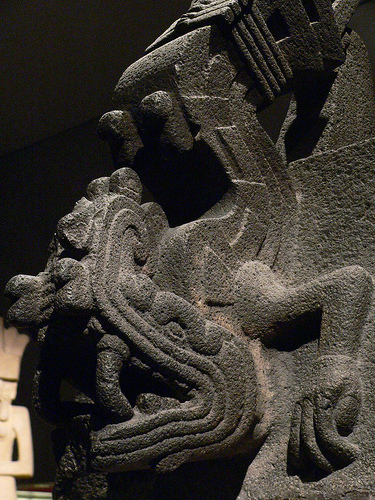
The fire serpent is no ordinary snake because it has two arms.
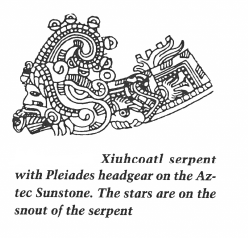
This drawing is from the Aztec sun stone. You can see seven or eight orbs on its snout. Xiuhcoatl is devouring someone in this representation.

The Aztec sun stone with two fire serpents on its perimeter. Both serpents have multiple orbs on their snout.
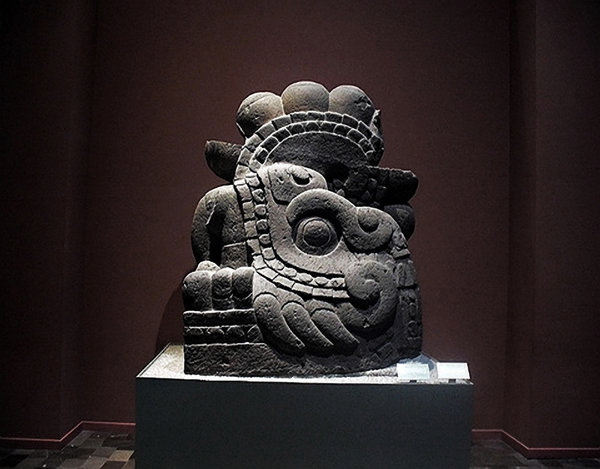
This head of the serpent only shows three orbs.

This is the feathered serpent temple at Teotihuacan. Xiuhcoatl is the one with the donut circles and rattle tail.
The orb symbol seems very important with this serpent creature. These orbs could represent stars or terrestrial UFO’s. Only after unlocking the next three chambers will we really know.


If those yellow spots really were once orbs then they possibly represent the spheres on Xiuhcoatl’s snout. Xiuhcoatl is known as the Aztec fire serpent and it is adorned on the façade of the feathered serpent temple at Teotihuacan. Here are a few pictures of Xiuhcoatl.

Xiuhcoatl has the tail of a rattlesnake.

The fire serpent is no ordinary snake because it has two arms.

This drawing is from the Aztec sun stone. You can see seven or eight orbs on its snout. Xiuhcoatl is devouring someone in this representation.

The Aztec sun stone with two fire serpents on its perimeter. Both serpents have multiple orbs on their snout.

This head of the serpent only shows three orbs.

This is the feathered serpent temple at Teotihuacan. Xiuhcoatl is the one with the donut circles and rattle tail.
The orb symbol seems very important with this serpent creature. These orbs could represent stars or terrestrial UFO’s. Only after unlocking the next three chambers will we really know.
Interesting, while i am not fully convinced.
I would like to add a link with pics of the position of the digsite and some 3D mapping of the site.
Unfortunately i can't embed the pics here, so you have to go there
Click the pics
I would like to add a link with pics of the position of the digsite and some 3D mapping of the site.
Unfortunately i can't embed the pics here, so you have to go there
Click the pics
edit on 6-5-2013 by Mianeye
because: (no reason given)
reply to post by lostinspace
S& F... Excellent detective work!!! Thank- you for possibly solving this mystery... It makes sense!
S& F... Excellent detective work!!! Thank- you for possibly solving this mystery... It makes sense!
Excellent thread thank you
I've been discussing this at work with a colleague Whilst this may not be definitive proof it is at the very least a very plausible theory.
Thanks again S&F
Cody
I've been discussing this at work with a colleague Whilst this may not be definitive proof it is at the very least a very plausible theory.
Thanks again S&F
Cody
Apparently the balls were clay clad with the mineral Pyrite which has now decomposed:
The Maya made mirrors from Pyrite.
The Maya made mirrors from Pyrite.
Originally posted by yampa
Apparently the balls were clay clad with the mineral Pyrite which has now decomposed:
The Maya made mirrors from Pyrite.
How did you come to this conclusion that these balls were clad in Pyrite????
Did you actually read the papers?
The composition of the balls is a Ball of Clay covered in yellow material called JAROSITE
Remember JAROSITE and Not PYRITE!!!
Originally posted by coredrill
How did you come to this conclusion that these balls were clad in Pyrite????
Did you actually read the papers?
The composition of the balls is a Ball of Clay covered in yellow material called JAROSITE
Remember JAROSITE and Not PYRITE!!!
Um, the Jarosite is caused by the decomposition of Pyrite or other iron sulfides
en.wikipedia.org...
"This sulfate mineral is formed in ore deposits by the oxidation of iron sulfides. "
www.otago.ac.nz...
Same rock specimen as above, showing the outside surface. The yellow-brown stain on the rock surface is formed as the pyrite and marcasite decompose in rainwater to jarosite (yellow sulphate mineral) and limonite (brown rusty iron oxide).
edit on 7-5-2013 by yampa because:
(no reason given)
reply to post by yampa
They may have shimmered like balls of fire in the presence of flame or sun. It could have been similar to this ball of fire in this image at Chalcatzingo, a Mesoamerican site dating back to 1500 BCE.
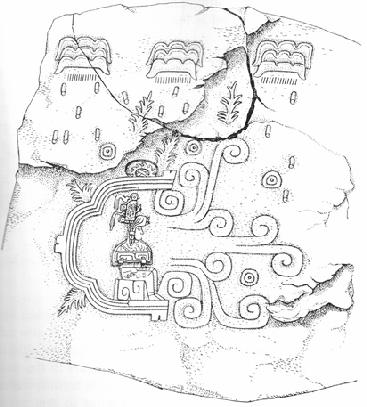
Sketch of Monument 1, El Rey, at Chalcatzingo. The ball of fire is sitting on the flying cave.

The actual relief of El Rey
A link to an image of the whole monument
They may have shimmered like balls of fire in the presence of flame or sun. It could have been similar to this ball of fire in this image at Chalcatzingo, a Mesoamerican site dating back to 1500 BCE.

Sketch of Monument 1, El Rey, at Chalcatzingo. The ball of fire is sitting on the flying cave.

The actual relief of El Rey
A link to an image of the whole monument
reply to post by yampa
Does the wiki article state pyrite?
Iron sulphides are a group and to imply that the Clay balls were covered in Pyrite because jarosite is a by product of oxidation of iron Suphides.
Then why didnt you state that the clay balls were covered with Marcasite, which also is a Iron Sulphide?
Just because, a shiny compound of Pyrite is more attractive than a non shiny compound of Marcasite, right???
Does the wiki article state pyrite?
Iron sulphides are a group and to imply that the Clay balls were covered in Pyrite because jarosite is a by product of oxidation of iron Suphides.
Then why didnt you state that the clay balls were covered with Marcasite, which also is a Iron Sulphide?
Just because, a shiny compound of Pyrite is more attractive than a non shiny compound of Marcasite, right???
Originally posted by coredrill
reply to post by yampa
Does the wiki article state pyrite?
Iron sulphides are a group and to imply that the Clay balls were covered in Pyrite because jarosite is a by product of oxidation of iron Suphides.
Then why didnt you state that the clay balls were covered with Marcasite, which also is a Iron Sulphide?
Just because, a shiny compound of Pyrite is more attractive than a non shiny compound of Marcasite, right???
Ok, yes, it could be coated in another iron sulfide (I did say 'or other iron sulfides'). But it's not only me making the connection with pyrite.
George Cowgill, professor emeritus at Arizona State University, told Discovery News the find was “unique”.
He said: “Pyrite was certainly used by the Teotihuacanos and other ancient Mesoamerican societies. Originally the spheres would have shone brilliantly. They are indeed unique, but I have no idea what they mean.”
The walls of the tunnels are covered in a mineral powder made up of magnetite, pyrite and hematite.
Do you have any reason to favour marcasite? Pyrite is the most common iron suphate decorative material known to be used by the Teotihuacanos. What's your beef with pyrite?
Whatever the actual material, the balls were likely never deliberately covered in jarosite.
edit on 9-5-2013 by yampa because: (no reason given)
Just that you are stating assumptions related to Pyrites just for the sensationalism because it is quite shiny.
Thats my beef. Wheres my beer?
Thats my beef. Wheres my beer?
I just wanted to point out that there is a feathered serpent base relief at Chalcatzingo. As you walk eastward from monument 1 (the one with the
little fire ball) you run into a base relief depicting a serpent creature devouring a human.

en.wikipedia.org...
The object protruding out of the serpent’s head kind of reminds me of a horn. The feathered serpent creature at Teotihuacan is portrayed with curved horns. Also, the mention of triangular markings at the end of its tail reminded me of the Xiuhcoatl tail iconography.
Here’s a small sketching of Monument 5
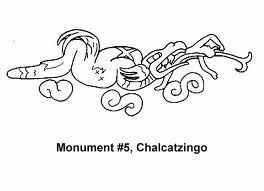
I wonder if some people from Chalcatzingo founded Teotihuacan?

Monument 5 depicts a reptilian creature, perhaps the archetypical Mesoamerican feathered serpent, devouring (or, less likely, disgorging) a human. The creature has an elongated snout with large fangs, and triangular markings towards its tail as well as what appear to be fins or wings.
en.wikipedia.org...
The object protruding out of the serpent’s head kind of reminds me of a horn. The feathered serpent creature at Teotihuacan is portrayed with curved horns. Also, the mention of triangular markings at the end of its tail reminded me of the Xiuhcoatl tail iconography.
Here’s a small sketching of Monument 5

I wonder if some people from Chalcatzingo founded Teotihuacan?
Originally posted by lostinspace
reply to post by yampa
They may have shimmered like balls of fire in the presence of flame or sun. It could have been similar to this ball of fire in this image at Chalcatzingo, a Mesoamerican site dating back to 1500 BCE.
Sketch of Monument 1, El Rey, at Chalcatzingo. The ball of fire is sitting on the flying cave.
This pic looks like a big ship( bottom one) trying to take off by moving left and 3 smaller ships flying above it dropping bombs on it.
Am i the only one seeing this ?
new topics
-
Hate makes for strange bedfellows
US Political Madness: 1 hours ago -
Who guards the guards
US Political Madness: 3 hours ago -
Has Tesla manipulated data logs to cover up auto pilot crash?
Automotive Discussion: 5 hours ago -
whistleblower Captain Bill Uhouse on the Kingman UFO recovery
Aliens and UFOs: 10 hours ago
top topics
-
CIA botched its handling of sexual assault allegations, House intel report says
Breaking Alternative News: 15 hours ago, 11 flags -
whistleblower Captain Bill Uhouse on the Kingman UFO recovery
Aliens and UFOs: 10 hours ago, 10 flags -
Who guards the guards
US Political Madness: 3 hours ago, 7 flags -
Hate makes for strange bedfellows
US Political Madness: 1 hours ago, 6 flags -
1980s Arcade
General Chit Chat: 12 hours ago, 5 flags -
Teenager makes chess history becoming the youngest challenger for the world championship crown
Other Current Events: 14 hours ago, 4 flags -
Deadpool and Wolverine
Movies: 13 hours ago, 4 flags -
Has Tesla manipulated data logs to cover up auto pilot crash?
Automotive Discussion: 5 hours ago, 2 flags
active topics
-
"We're All Hamas" Heard at Columbia University Protests
Social Issues and Civil Unrest • 224 • : namehere -
Candidate TRUMP Now Has Crazy Judge JUAN MERCHAN After Him - The Stormy Daniels Hush-Money Case.
Political Conspiracies • 662 • : network dude -
Hate makes for strange bedfellows
US Political Madness • 9 • : crayzeed -
Deadpool and Wolverine
Movies • 3 • : 5thHead -
IDF Intel Chief Resigns Over Hamas attack
Middle East Issues • 38 • : HopeForTheFuture -
Europe declares war on Russia?
World War Three • 62 • : 777Vader -
1980s Arcade
General Chit Chat • 13 • : Bluntone22 -
British TV Presenter Refuses To Use Guest's Preferred Pronouns
Education and Media • 110 • : Annee -
Michael Avenatti Says He Will Testify FOR Trump
US Political Madness • 61 • : JadedGhost -
Who guards the guards
US Political Madness • 2 • : budzprime69
10

